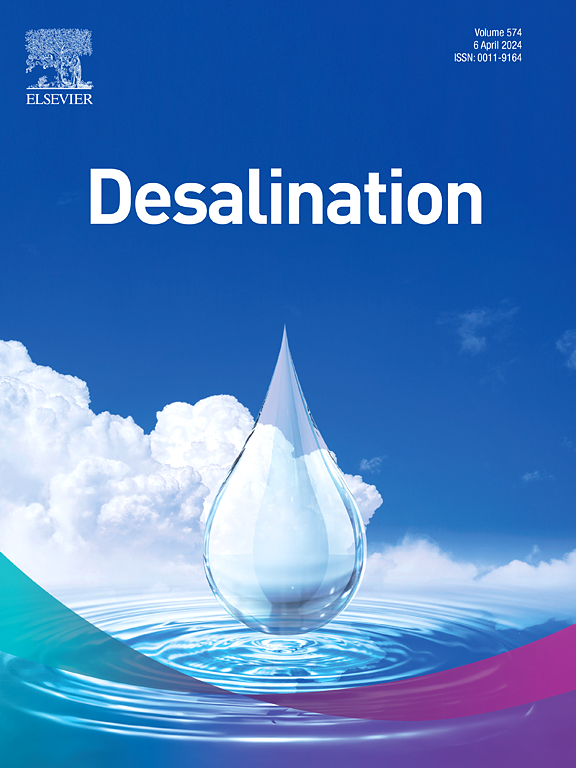Sustainable and selective capture of Ca2+/Mg2+ from seawater desalination brines via hierarchical chitosan-based biochar aerogel adsorption
IF 8.3
1区 工程技术
Q1 ENGINEERING, CHEMICAL
引用次数: 0
Abstract
To address the challenge of removing high-concentration calcium and magnesium ions (Ca2+/Mg2+) from seawater desalination brines (SDB), this study introduces a novel chitosan-based biochar aerogel (CBA) system specifically engineered for hypersaline water treatment. The innovative adsorbent material utilizes high-temperature pyrolysis chitosan (85 % and 95 % deacetylation degree (DD)) generate biochar and then crosslinked into three-dimensional porous aerogels (CBA85 and CBA95), which were compared with conventional activated carbon aerogel (ACA). Comprehensive characterization revealed that CBA95 exhibited a high density of free amino groups and a well-developed mesoporous structure, with a specific surface area of 107.04 m2/g, approximately 3.14 times that of ACA. The maximum adsorption capacities of CBA95 for Ca2+ and Mg2+ were 5.15 mg/g and 9.37 mg/g, respectively. Selectivity adsorption experiments demonstrated CBA95 exhibited high selectivity for Ca2+ and Mg2+, with distribution coefficient (Kd) of 164.25 mL/g and 42.73 mL/g, respectively. The equilibrium data were aligned with the Langmuir isotherm model, suggesting a monolayer chemical adsorption mechanism, and further the electrostatic and complexation adsorption mechanism was identified and proposed. Most notably, fixed-bed reactor of CBA95 maintains over 87 % of Ca2+ and 91 % of Mg2+ removal efficiency after 9 adsorption-desorption cycles. The pilot-scale experiment of CBA95 in Qingdao SDB achieved 72.3 % Ca2+ and 74.6 % Mg2+ removal, confirming high industrial potential. Thus, this research not only establishes a theoretical foundation for applying chitosan-based materials in SDB softening but also provides a solution for large-scale engineering-scale applications due to their environmental sustainability and potential.

分层壳聚糖基生物炭气凝胶吸附法可持续、选择性地捕获海水淡化盐水中的Ca2+/Mg2+
为了解决从海水淡化盐水(SDB)中去除高浓度钙镁离子(Ca2+/Mg2+)的挑战,本研究介绍了一种新型的壳聚糖基生物炭气凝胶(CBA)系统,该系统专门用于高盐水处理。该新型吸附材料利用高温热解壳聚糖(85%和95%脱乙酰度(DD))生成生物炭,然后交联成三维多孔气凝胶(CBA85和CBA95),并与常规活性炭气凝胶(ACA)进行比较。综合表征表明,CBA95具有高密度的游离氨基和发育良好的介孔结构,其比表面积为107.04 m2/g,约为ACA的3.14倍。CBA95对Ca2+和Mg2+的最大吸附量分别为5.15 mg/g和9.37 mg/g。选择性吸附实验表明,CBA95对Ca2+和Mg2+具有较高的选择性,分布系数Kd分别为164.25 mL/g和42.73 mL/g。平衡数据与Langmuir等温线模型一致,表明其为单层化学吸附机制,并进一步确定了静电吸附和络合吸附机制。最值得注意的是,CBA95固定床反应器在经过9次吸附-解吸循环后,Ca2+和Mg2+的去除率分别保持在87%和91%以上。CBA95在青岛深发展中试中Ca2+去除率为72.3%,Mg2+去除率为74.6%,具有较高的工业潜力。因此,本研究不仅为壳聚糖基材料在SDB软化中的应用奠定了理论基础,而且由于其环境可持续性和潜力,为大规模工程规模的应用提供了解决方案。
本文章由计算机程序翻译,如有差异,请以英文原文为准。
求助全文
约1分钟内获得全文
求助全文
来源期刊

Desalination
工程技术-工程:化工
CiteScore
14.60
自引率
20.20%
发文量
619
审稿时长
41 days
期刊介绍:
Desalination is a scholarly journal that focuses on the field of desalination materials, processes, and associated technologies. It encompasses a wide range of disciplines and aims to publish exceptional papers in this area.
The journal invites submissions that explicitly revolve around water desalting and its applications to various sources such as seawater, groundwater, and wastewater. It particularly encourages research on diverse desalination methods including thermal, membrane, sorption, and hybrid processes.
By providing a platform for innovative studies, Desalination aims to advance the understanding and development of desalination technologies, promoting sustainable solutions for water scarcity challenges.
 求助内容:
求助内容: 应助结果提醒方式:
应助结果提醒方式:


